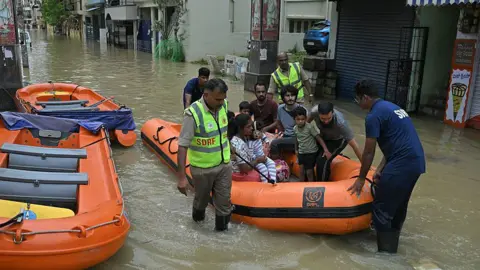The recent flooding in Bengaluru, often referred to as India’s “Silicon Valley,” has raised significant concerns amongst its residents and local authorities alike. Heavy rainfall has submerged numerous parts of the city, leading to disruptions in daily life and tragic fatalities. Reportedly, nearly three individuals lost their lives due to rain-related incidents, one of whom was a 12-year-old boy. The deluge has prompted major tech companies operating in the region to advise their employees to work from home, reflecting the scale of the impact on the city’s infrastructure.
As of May 19, 2025, Bengaluru experienced an extraordinary rainfall event that produced over 100 millimeters (approximately 4 inches) of rain within a single day. Such rainfall totals are considered rare for the city, a fact emphasized by CS Patil, a director at the regional weather department, who noted this record-breaking precipitation had not been seen since 2011. The city is on heightened alert for further pre-monsoon showers as cyclonic formations loom over the Andaman Sea.
Moreover, the storms have caused significant disturbances across the metropolis. Streets that were once bustling with commuters have turned into waterways, and many locals were photographed navigating knee-deep water. Videos circulating on social media depict vehicles stranded on submerged roads, and residents have reported water breaches into their homes. This flooding highlights ongoing issues concerning Bengaluru’s drainage and water management systems, all under scrutiny from both citizens and civic officials.
In addition to disruptions and property damage, the rainfall led to a tragic incident in which the compound wall of a software firm, i-Zed, collapsed, resulting in the death of a 35-year-old female employee. Local authorities have since identified 210 flood-prone areas and are reportedly working diligently to address the vulnerabilities in these locations. Karnataka’s Deputy Chief Minister, DK Shivakumar, reassured residents by stating that there was no need for them to panic given the efforts in place to mitigate the impact.
The political implications of the disaster have been significant as well. Currently, the Karnataka state is governed by the Congress party, while the Bharatiya Janata Party (BJP), which is in opposition, has been vocal about the alleged failures of the local government to manage the repercussions of heavy rain. The BJP has demanded an immediate allocation of 10 billion rupees (equivalent to $117 million or £87.5 million) for relief operations, further complicating the narrative surrounding the flooding crisis.
In defense, state officials have argued that the flooding issues in Bengaluru are longstanding challenges that have not been adequately addressed over various administrations. Shivakumar pointed out that the problems troubling the city today are not new; rather, they have been sidelined for years. Rapid urban construction over the city’s lakes and wetlands has been pointed to as a critical factor in exacerbating the flooding issue, underscoring the need for better urban planning.
Public sentiment reflects mounting frustration over the city’s deteriorating infrastructure. Social media platforms have become hotbeds of criticism, with citizens sharing their grievances regarding the inadequate response to flooding and the persistent problems caused by a lack of effective management. As Bengaluru continues to grapple with heavy rainfall and its aftermath, the incident serves as a sobering reminder of the consequences of rapid urbanization without sustainable planning.
In conclusion, Bengaluru’s flooding crisis showcases the urgent need for comprehensive urban planning and climate resilience strategies. As authorities work to address the current flooding and its consequences, the call for systemic change echoes through the ranks of local leadership and the city’s residents alike. With both immediate and long-term solutions required, Bengaluru’s future may depend on the stewardship of its governance and the commitments made to improve its resilience against such natural disasters.



